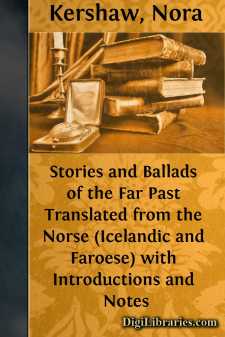Categories
- Antiques & Collectibles 13
- Architecture 36
- Art 48
- Bibles 22
- Biography & Autobiography 813
- Body, Mind & Spirit 142
- Business & Economics 28
- Children's Books 17
- Children's Fiction 14
- Computers 4
- Cooking 94
- Crafts & Hobbies 4
- Drama 346
- Education 46
- Family & Relationships 57
- Fiction 11829
- Games 19
- Gardening 17
- Health & Fitness 34
- History 1377
- House & Home 1
- Humor 147
- Juvenile Fiction 1873
- Juvenile Nonfiction 202
- Language Arts & Disciplines 88
- Law 16
- Literary Collections 686
- Literary Criticism 179
- Mathematics 13
- Medical 41
- Music 40
- Nature 179
- Non-Classifiable 1768
- Performing Arts 7
- Periodicals 1453
- Philosophy 64
- Photography 2
- Poetry 896
- Political Science 203
- Psychology 42
- Reference 154
- Religion 513
- Science 126
- Self-Help 84
- Social Science 81
- Sports & Recreation 34
- Study Aids 3
- Technology & Engineering 59
- Transportation 23
- Travel 463
- True Crime 29
Stories and Ballads of the Far Past Translated from the Norse (Icelandic and Faroese) with Introductions and Notes
by: Nora Kershaw
Description:
Excerpt
THE SAGAS
GENERAL INTRODUCTION
The following stories are taken from the Fornaldarsögur Northrlanda, or 'Stories of Ancient Times relating to the countries of the North'—a collection of Sagas edited by Rafn in 1829-30 and re-edited by Valdimar Ásmundarson in 1886-1891. The stories contained in this collection deal almost exclusively with times anterior to Harold the Fairhaired (c. 860-930) and the colonisation of Iceland, and stop therefore where the better known stories relating to Iceland and the historical kings of Norway begin. Some of them relate to persons and events of the ninth century, while others are concerned with times as remote as the fourth or fifth centuries. Their historical value is naturally far inferior to that of the Íslendinga Sögur, or 'Stories of Icelanders' and the Konunga Sögur, or 'Stories of the Kings.'
From the literary point of view also the 'Stories of Ancient Times' are generally much inferior to the others. The 'Stories of Icelanders' are derived from oral tradition, which generally goes back in more or less fixed form to the time at which the characters in the stories lived, and they give us a vivid picture of the persons themselves and of the conditions of life in their time. In the 'Stories of Ancient Times,' on the other hand, though there is some element derived from tradition, often apparently of a local character, it is generally very meagre. More often perhaps the source of the stories is to be found in poems, notable instances of which will be found in Hervarar Saga and in Völsunga Saga. In many cases, however, the stories without doubt contain a large proportion of purely fictitious matter.
The texts of the 'Stories of Ancient Times' which have come down to us date as a rule from the thirteenth and the beginning of the fourteenth centuries though the actual MSS. themselves are generally later. Most of the stories, however, were probably in existence before this time. The Danish historian Saxo Grammaticus (c. 1200) was familiar with many of them, including the story of Hethin and Högni[1] and one of the scenes recorded in Hervarar Saga[2]. And we are told that a story which seems to have corresponded, in its main outlines at least, to the story of Hromund Greipsson was composed and recited at a wedding in Iceland in 1119[3]. But in many cases the materials of our stories were far earlier than this, though they no doubt underwent considerable changes before they assumed their present form.
Indeed many stages in the literary history of the North are represented in the following translations. Of these probably the oldest is that section of the Hervarar Saga which deals with the battle between the Goths and the Huns "at Dylgia and on Dunheith and upon all the heights of Jösur." The poetry here included in the saga dates even in its present form probably from the Viking Age, perhaps from the tenth century. But the verses themselves do not appear to be all of the same date. Some of them show a certain elaboration and a sense of conscious art, while others are comparatively bare and primitive in type and contain very early features[4]; and there is every probability that such poetry was ultimately derived from poetry composed at a time when the Goths were still remembered....


